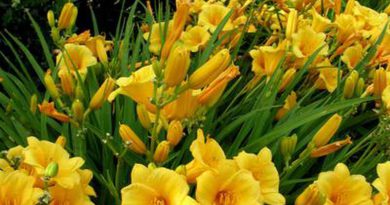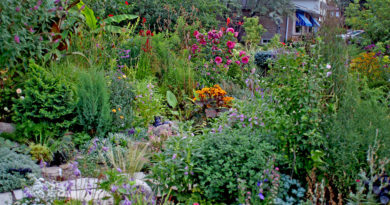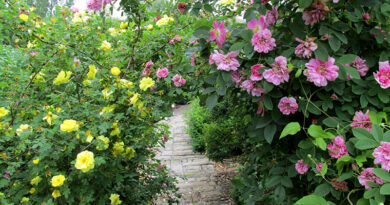Lucille’s Garden
Lucille Crighton
Toronto, Ontario
People often talk about weaving texture, colour and form into the garden, making an educated guess about how a plant will fit into a spot. Lucille Crighton brings this sensibility to her Beaches garden in Toronto, along with the experience of being a weaver. “As a weaver, I’m dealing with texture and colour every day, and I find I’m doing the same thing in the garden. I’m contrasting colour, texture, you know… the big flat leaf of a hosta with the upright skinny grasses and things like that,” she says.
This is the house where she grew up, her grandfather having bought it in 1927; when her mother passed, Lucille moved in and has been there for 30 years. She had moved away as a young adult, living in an old farmhouse with five acres, just south of Barrie, when her three kids were small. But the Beaches house is where she has roots and where she actively puts in roots.
It’s a big yard, 50 by 118 feet (“and it gets bigger the older I get!” she quips), by Toronto standards, but there is no sun. Maybe a couple of pockets, where she grows daisies. “There are a lot of oak trees. There are two huge oaks in the front. And in the back there is one 30-foot Japanese maple and four oaks. I don’t think there’s any place where I get full sun.” There is also a big, three-storey house to the south.
Being a voracious reader, Lucille has read plenty about the plants she grows and would like to grow in her garden. She kept a record of all her plants on her computer for the past 20 years—and it’s quite a record. Ringing in at 107 pages, it tells the name of the plant and includes a picture from the Internet. She considered doing the master gardener courses at one time, so she kept assiduous notes on what was growing in her garden. “I think about the plants and what they need, but I also think about the design. You have to know about the plants before you can think of design.”
Lucille takes care of her garden by herself. For the first time she hired somebody this year to spread the vermicompost she bought—two yards—because she has tears in her shoulder from weaving. The raking in the spring is a big job; she leaves the leaves through the winter and removes them in the spring. (There are so many oak leaves, they won’t break down.) She had over 50 bags this spring. But she enjoys the work. “When you’re raking and you see all these little sprouts coming up…” she says with a shiver. “When I’m in the garden I don’t think of anything else. It’s relaxing to me. It’s good physical work, but its also relaxing.”
As a plantsman, she has a few rare varieties. One of her favourites is her Hydrangea aspera. It’s a gorgeous hydrangea, about six feet high with downy leaves. You don’t see it very often here, but she found it at an end-of-the-year bin at Humber Nurseries 18 or 20 years ago. She had read about it and grabbed it. It’s listed as hardy to USDA Zone 7, but she keeps it going.
Lucille has or has tried most shade-loving plants in her garden, including many you don’t see all that often. Everything from astilbe (including a Chinese one that creeps), ferns (including Japanese painted) and bleeding hearts to liriope, kirengeshoma and sanguinaria has a spot on her list. To find these plants, she shops at several garden centres. Humber Nurseries has been a favourite, though it is closing to the public at the end of this season. Others are Mason House Gardens, Vandermeer Nursery and Lost Horizons Nursery. None of them is in Toronto, but you will travel for what you want.
Well, you travel when you can justify it. “I try not to go to garden centres, but I’m just chomping at the bit waiting to go. And I need nothing,” she says, adding after a slight pause, “except some annuals.”
Annuals Lucille grows in about eight pots in the garden each year. “For colour, I’m basically mixing leaf sizes and colours. I’m getting burgundy leaves and lime green leaves and different sizes, and that’s where I get the drama from.”
She works on colour from foliage in the perennial garden, but it is subtler than in the containers. For heucheras, she’s found that ‘Obsidian’, an almost-black cultivar, does best, along with the other purple-leafed varieties. The yellower cultivars of heuchera don’t appreciate the lack of sun. Hakonechloa grass adds some chartreuse, and there are variegated sedums and hostas and Japanese painted ferns to add to the green. There are the blooms of ligularia, hydrangea, astilbe and trillium as well, and bulbs in spring and early summer.
The 30-foot Japanese maple in the side yard she put in many years ago. She thinks it is a species of Acer palmatum. It turns a brilliant bright orange in the fall that gladdens her heart. She is very fond of autumn. But she also loves summer, when she goes around the garden with her coffee every morning. And spring, which is the busiest and most exciting time of the year. “It’s really beautiful in all seasons,” she acknowledges.
Story by Shauna Dobbie
Photos by Lucille Crighton




